 | 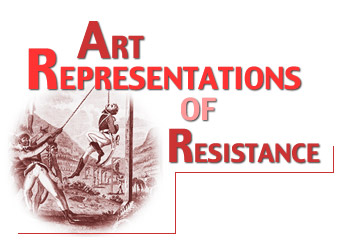
 |
In the introduction to his An Historical Account of the Black Empire of Haiti, published in 1805, Marcus Rainsford states that "mere description conveys not with so much force as when accompanied by graphic illustrations those horrors which are wished to be impressed on the public mind." In this case he refers to the Haitian Revolution. The "graphic illustrations" in his book, engravings based on the actual sketches from his visit to the island, can help to understand the resistance of slaves against the French during the Haitian Revolution. Not only do they demonstrate numerous forms of resistance, but they are also a reflection the British attitude towards these particularly rebellious black slaves. In order to grasp the dualistic nature of these illustrations, one must understand the difference between simply seeing the blacks as rebellious slaves and seeing them as equal leaders of the first independent country in the New World. Even the title of Rainsford’s book indicates that the motivation for his sketches drew upon more egalitarian ideals. Eighteenth-century illustrations included in Albert Savine’s Saint Domingue a la veille de la Revolution drawn by French artists convey quite the opposite. Published in the United States in 1911, the text recounts Baron de Wimpffen’s visit to Haiti during 1788-1790, but the depictions of slave resistance appended to Wimpffen’s text reveal that the French viewed blacks as an inferior and primitive people.
To comfort the reader, Rainsford states in a disclaimer that "he is desirous to avoid the appearance of enlarging on a subject which regards a country against whom his own is in hostilities." Essentially, he is alluding to the long rivalry in the Caribbean between Britain and France. The animosity began over the competition for the European sugar market between the French territory of San Domingo and the British Jamaica. It later became a battle over the slave trade, the British being strong advocates of abolition and the French, major importers of African slaves. However, by 1805, the year in which Rainsford’s book was published, the issue of slavery was, at least for the moment, a moot point. By this time, Europe was more concerned with the Napoleonic Wars. Consequently, the British questioned the French attempts to reconquer the former slaves of Haiti, rather than the issue of the slave trade itself. Thus, Rainsford’s Empire of Haiti became a call to Britain to aid in the slaves’ efforts towards an independent Haiti.
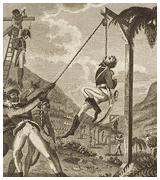
The representations of resistance by both the British and French take on several forms. For instance, Rainsford’s plate entitled "Revenge taken by the Black Army for the Cruelties practiced on them by the French" depicts the slaves in active resistance, probably during the French invasions from 1801-1803. The black soldiers, very European in appearance because of their uniforms, take an enemy camp by siege and hang all the French soldiers. In this case, Rainsford is portraying the actual act of resisting through violence.
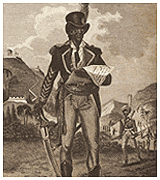 Other images depict the slaves in forms of cultural, or passive resistance. In the Empire of Haiti, Rainsford includes a full body portrait of Toussaint L’Ouverture standing in uniform at the center of the plate. He seems to be leading his army to a French camp in the distance. Toussaint is represented as a dignified soldier with a sword in one hand and a battle plan in the other. Typical of male portraits, he faces the viewer head on with a forceful glare as if asserting his authority. Observing this image, one is left with the impression that Rainsford probably sketched Toussaint in the same way he would a British soldier. In fact, he describes this black leader by stating, "his principles were as pure and legitimate as those which actuated the great founders of liberty in any former age or clime." Other images depict the slaves in forms of cultural, or passive resistance. In the Empire of Haiti, Rainsford includes a full body portrait of Toussaint L’Ouverture standing in uniform at the center of the plate. He seems to be leading his army to a French camp in the distance. Toussaint is represented as a dignified soldier with a sword in one hand and a battle plan in the other. Typical of male portraits, he faces the viewer head on with a forceful glare as if asserting his authority. Observing this image, one is left with the impression that Rainsford probably sketched Toussaint in the same way he would a British soldier. In fact, he describes this black leader by stating, "his principles were as pure and legitimate as those which actuated the great founders of liberty in any former age or clime."
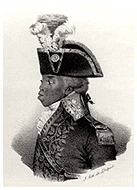 On the other hand, the French artist, Nicolas Eustache Maurin also lithographed a portrait of Toussaint L’Ouverture in 1832 for the book Iconographie des contemporains. At first glance, this image does not appear to be a representation of resistance. However, the fact that the artist acknowledges the importance of Toussaint and that he is seen wearing a highly decorated uniform, makes it so. This Frenchman accepts the resistance of the slaves, but still does not recognize him as an equal. Unlike Rainsford’s portrayal of Toussaint, Maurin paints a one-sided image of the great black leader. This style of profile portraiture was usually only utilized for female portraits because women were not worthy of facing the viewer directly. Such is the case with this portrait of Toussaint. The artist strips this hero of his dignity and status by placing him in a subservient role often associated with women. Furthermore, Toussaint is depicted as having an ape-like face, suggesting his idea of the African race as inferior. On the other hand, the French artist, Nicolas Eustache Maurin also lithographed a portrait of Toussaint L’Ouverture in 1832 for the book Iconographie des contemporains. At first glance, this image does not appear to be a representation of resistance. However, the fact that the artist acknowledges the importance of Toussaint and that he is seen wearing a highly decorated uniform, makes it so. This Frenchman accepts the resistance of the slaves, but still does not recognize him as an equal. Unlike Rainsford’s portrayal of Toussaint, Maurin paints a one-sided image of the great black leader. This style of profile portraiture was usually only utilized for female portraits because women were not worthy of facing the viewer directly. Such is the case with this portrait of Toussaint. The artist strips this hero of his dignity and status by placing him in a subservient role often associated with women. Furthermore, Toussaint is depicted as having an ape-like face, suggesting his idea of the African race as inferior.
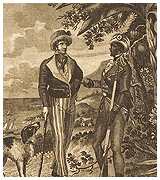 Not only does Rainsford exalt the leaders of the Revolution as in his portrait of Toussaint L’Ouverture, but he also dedicates a large portion of his book to the description of the "Black Empire" and its people. In the plate entitled "The Author in Conversation with a private soldier of the Black Army on his excursion in St. Domingo," Rainsford is standing next to and at the same level as a black officer in uniform. The two seem to be engaged in conversation. This depiction implies a sense of equality, as if the black soldier was his peer. Interestingly, the black soldier is standing on the right side of the plate surrounded by Haiti’s natural landscape, including a banana tree. Rainsford is standing on the left side. The landscape behind him is the island’s coastline and several ships. This scene of freedom and resistance is probably one of the first times one sees the black man coming out from his land to greet and welcome the visitor coming by sea. It emphasizes that Haiti was no longer the French colony, but by 1805, the "Black Empire" and the only independent black country in the New World. Not only does Rainsford exalt the leaders of the Revolution as in his portrait of Toussaint L’Ouverture, but he also dedicates a large portion of his book to the description of the "Black Empire" and its people. In the plate entitled "The Author in Conversation with a private soldier of the Black Army on his excursion in St. Domingo," Rainsford is standing next to and at the same level as a black officer in uniform. The two seem to be engaged in conversation. This depiction implies a sense of equality, as if the black soldier was his peer. Interestingly, the black soldier is standing on the right side of the plate surrounded by Haiti’s natural landscape, including a banana tree. Rainsford is standing on the left side. The landscape behind him is the island’s coastline and several ships. This scene of freedom and resistance is probably one of the first times one sees the black man coming out from his land to greet and welcome the visitor coming by sea. It emphasizes that Haiti was no longer the French colony, but by 1805, the "Black Empire" and the only independent black country in the New World.
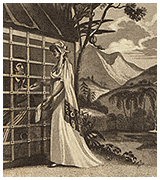 Rainsford addresses the black woman in an illustration entitled "The Author when under sentence of Death relieved by a Benevolent Female of Color." His depiction of the slave woman is clearly idealized, but quite significant. Rainsford sketched himself sitting down with the woman standing above him. The norm was to always place the woman lower than the man, especially a woman of color. He clearly does not regard her as a subservient slave, but rather as "a fine figure, rather tall and slender with a face most beautiful...dressed in superior style and possessed all the elegance of European manners." In discussing the issue of interracial relations he explains that "different degrees of color which remained, lost most of that natural hostility which formerly Rainsford addresses the black woman in an illustration entitled "The Author when under sentence of Death relieved by a Benevolent Female of Color." His depiction of the slave woman is clearly idealized, but quite significant. Rainsford sketched himself sitting down with the woman standing above him. The norm was to always place the woman lower than the man, especially a woman of color. He clearly does not regard her as a subservient slave, but rather as "a fine figure, rather tall and slender with a face most beautiful...dressed in superior style and possessed all the elegance of European manners." In discussing the issue of interracial relations he explains that "different degrees of color which remained, lost most of that natural hostility which formerly 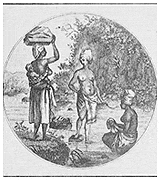 existed." existed."
In contrast to Rainsford’s glorification of Haitian men and women, "Lavandieres de Saint-Domingue" done by the French illustrator Abraham Brunias, portrays three African woman washing clothes by the river. All three are half naked with a cloths wrapped around their waists. One woman has an infant strapped to her back and is balancing a large basket on her head. By depicting the slaves in such a way, the artist communicates his attitude of the slaves as being primitive and barbaric, as opposed to the refined and elegant people in Rainsford’s illustrations.
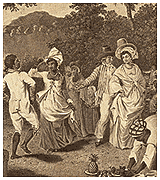 This idealized perception of the slaves by several British artists is further emphasized by the illustration "A Negro Festival drawn from Nature in the Island of St. Vincent." Although not sketched by Rainsford, this illustration of St. Vincent, pertains to this discussion due to its status as a British colony. Rather than blindly accepting European customs, the slaves continue specific African traditions such as the Calinda dance. All the figures are dressed in elegant European-like clothing. In fact, a black couple is dancing next to a white couple. Not only does the scene depict the Africans retaining their own culture, but the Europeans are included in it as well. Rainsford makes the two cultures comparable when he describes, "Sometimes they had, on holidays, a particular entertainment of activity, the principal part of which was the Calinda. The animation displayed was astonishing...equal to many ballets performed on the French or Italian stage." By doing so, he elevates the slaves to a European status. This idealized perception of the slaves by several British artists is further emphasized by the illustration "A Negro Festival drawn from Nature in the Island of St. Vincent." Although not sketched by Rainsford, this illustration of St. Vincent, pertains to this discussion due to its status as a British colony. Rather than blindly accepting European customs, the slaves continue specific African traditions such as the Calinda dance. All the figures are dressed in elegant European-like clothing. In fact, a black couple is dancing next to a white couple. Not only does the scene depict the Africans retaining their own culture, but the Europeans are included in it as well. Rainsford makes the two cultures comparable when he describes, "Sometimes they had, on holidays, a particular entertainment of activity, the principal part of which was the Calinda. The animation displayed was astonishing...equal to many ballets performed on the French or Italian stage." By doing so, he elevates the slaves to a European status.
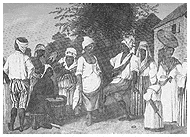 Brunias also illustrates "Danse de negres a Saint Domingue." Although this image also represents the cultural resistance of dancing, the two greatly differ. The French sketch the Africans in front of shacks, dressed in rags and torn garments. They move to the beat of the drum and tambourine, thought by Europeans of the day to be inferior instruments, used only for uncivilized rituals. Through such depictions, the artist denies the slaves that equal status with Europeans which Rainsford struggles to emphasize. To Brunias, they remain lowly, unsophisticated slaves. Brunias also illustrates "Danse de negres a Saint Domingue." Although this image also represents the cultural resistance of dancing, the two greatly differ. The French sketch the Africans in front of shacks, dressed in rags and torn garments. They move to the beat of the drum and tambourine, thought by Europeans of the day to be inferior instruments, used only for uncivilized rituals. Through such depictions, the artist denies the slaves that equal status with Europeans which Rainsford struggles to emphasize. To Brunias, they remain lowly, unsophisticated slaves.
Upon analysis of these illustrations, the viewer comes away with an understanding of different European views toward slave resistance in Haiti. Although Marcus Rainsford might not have been representative of the majority, his illustrations speak for those British who recognized both slave resistance and its success in the Black Empire of Haiti. Whether they did so in the name of freedom and equality or for the sake of a strategic position in the Caribbean. On the contrary, the French, like most whites, acknowledged slave opposition, but never accepted the slaves as anything but uncivilized, primitive people.
|
Rainsford, Marcus. A Historical Account of the Black Empire of Haiti (London, 1805). XIX.
Dunn, Richard. Sugar and Slaves (New York: W.W. Norton & Company,1972).
|

 |





